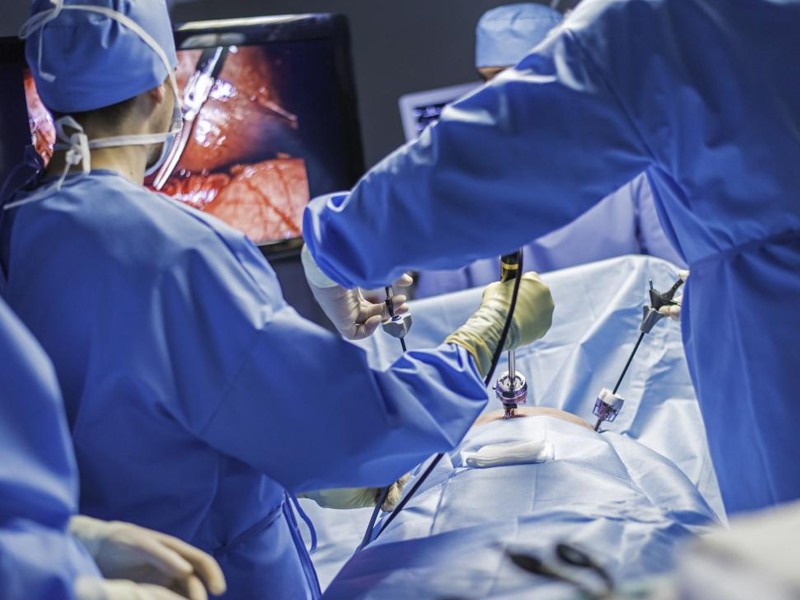Hysterectomy

The uterus is a muscular organ of a woman’s reproductive system. Its main function is the development of the embryo, bearing of the fetus and the birth of the fetus. If a woman is not pregnant, the uterus is directly involved in the woman’s menstrual cycle.
There are many diseases of the uterus, endometriosis, benign neoplasms, oncology and others. Most of these can be treated or alleviated. Although there can also be a severe course of the disease, when it does not respond to treatment and at the same time worsens the woman’s quality of life, or threatens it. In this case, doctors recommend a hysterectomy.
A hysterectomy is a gynecological surgery to remove the uterus. It is carried out in order to save the life of a woman. This is a radical surgery performed as a last resort and after previous failed attempts at treatment. Usually this decision is made collectively by a council of doctors, who examine each case separately, taking into account the patient’s age, the presence of children, concomitant diseases and the woman’s condition at the moment. Although, there are also urgent situations that require immediate solutions to save lives.
Indications for hysterectomy
Hysterectomy is used as an extreme method of treating certain diseases, when other methods have not yielded positive results or the question is about a woman’s life.
Common diseases for which hysterectomy is used:
- Pathological uterine bleeding. They can occur during menstruation and are caused by various medical conditions. A woman can lose a very large amount of blood in a short period of time, which will threaten her life. When other methods fail to stop the bleeding, doctors will remove the uterus.
- Endometriosis. A serious illness when endometrial cells begin to spread and move to the ovaries, tubes, and other organs. All this is accompanied by severe pain, inflammation, adhesions and uterine bleeding. Endometriosis often recurs and presents with more severe symptoms. Hysterectomy is the only method in the latter stages when hormonal and surgical treatment does not help.
- Prolapse of the uterus. Sometimes, due to the weakness of the pelvic muscles, prolapse of the uterus can occur through the vagina. Most often, this is a reverse process, but it happens that it is not possible to return the uterus to its place and it must be removed.
- Benign neoplasms of the uterus. They do not pose a threat to life and do not create discomfort in the initial stages. But quite often, tumors grow to very large sizes and can compress vessels and adjacent organs. In this case, the method of choice of treatment is the removal of the uterus with the tumor.
- Malignant tumors. Typically, cancer of the uterus can be contained and controlled through a variety of treatments. But cancer can cause severe pain, bleeding, and metastases to other organs. The uterus is removed in order to prevent the spread of the oncological process in the body.
- Severe uterine pains. They can be as a symptom of specific diseases or against the background of hormonal disorders of the menstrual cycle. Of course, most of these cases can be cured and hormones in the body adjusted. But it happens that the treatment does not help, and the woman’s quality of life decreases sharply. Then doctors recommend a hysterectomy.
- Rupture of the uterus during childbirth. Sometimes during childbirth, a complication such as rupture of the uterus can occur. This is an urgent situation that requires immediate action to save the woman’s life. The uterus is very well supplied with blood and, accordingly, when it ruptures, very severe bleeding occurs, which can lead to the death of a woman. The doctor must make an immediate decision and if there is no other option, he will perform an urgent hysterectomy.
Types of hysterectomy
Due to the fact that there are a lot of indications, there are also many types of hysterectomies that are used in specific cases:
- Subtotal hysterectomy – removal of the uterus while preserving the cervix.
- Total hysterectomy (extirpation of the uterus) – removal of the uterus with the cervix
- Hysterosalpingoovarectomy – removal of the uterus with appendages
- Radical hysterectomy – removal of the uterus with the cervix, appendages, 1/3 of the vagina, lymph nodes and peri-uterine tissue.
They are also divided according to the method of the operation:
- Open – open access through a laparotomy incision.
- Laparoscopic – minimally invasive surgery.
- Robotic – performed using an operating robot.
- Vaginal – respectively, removal of the uterus through the vagina.
- Combined – a combination of several methods.
Consequences of hysterectomy
First of all, after the operation, a woman loses the opportunity to become pregnant and give birth to a child. The menstrual cycle also stops. Removal of the uterus with appendages leads to menopause.
At this moment, the woman begins hormonal changes in the body. A woman may develop endocrine shock. After all, there is a sharp loss of an organ that was guided by hormones and due to this, a woman will feel herself, and concomitant diseases may also develop.
Therefore, in order to prevent such consequences, a woman is prescribed hormone replacement therapy, it will support the body. With the help of it, the transition will pass smoothly and reduce the woman’s discomfort. Studies also show that with replacement therapy, the risk of developing osteoporosis and cardiovascular diseases is much lower.
Recommendations after hysterectomy
Usually, if the operation took place without complications, the woman is discharged home within 5-7 days. But she still has a rehabilitation period that lasts on average 2-3 months.
During rehabilitation, a woman should adhere to the following recommendations:
- Eliminate physical activity, lift heavier 2-3 kg, do physical work. Also, you will need to wear a bandage on the lower abdomen, in order to support the muscles.
- Do not take hot baths, go to the bathhouse, during the first 2 months. Wash only under a warm shower.
- For a quick recovery after surgery, you need to adhere to proper nutrition. Eat vegetables, fruits, animal and vegetable proteins, carbohydrates. Eliminate legumes, fatty and fried foods. In the beginning, it is recommended to eat more liquid food, so as not to burden the intestines. In general, your diet should be balanced in micronutrients, vitamins and other nutrients.
- It is recommended to do Kegel exercises to avoid urinary problems.
- Take all hormone medications from the Prescribing List.
- After 2 months, you need to come to the doctor for an examination and take a blood test to determine the hormonal status.
Hysteroscopy and sex
The first sexual intercourse should be no earlier than 2 months later. Usually it can be accompanied by discomfort, but then everything returns to normal. If a woman has healthy ovaries, there will be no changes in her sex life. Sometimes sex attractioneven increases, because you don’t need to worry about pregnancy.
If the ovaries have been removed, then dryness in the vagina is possible, and accordingly it will be necessary to use additional moisturizing agents so as not to feel friction and pain.


